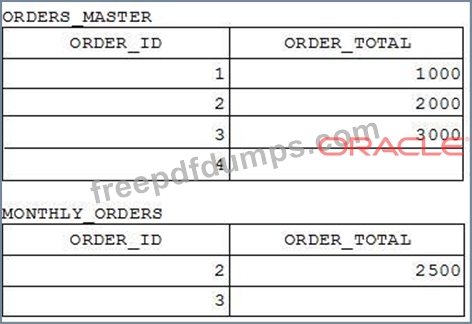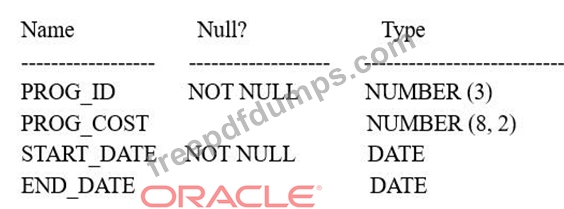1z1-071 Exam Question 176
You need to display the first names of all customers from the CUSTOMERS table that contain the character
'e' and have the character 'a' in the second last position.
Which query would give the required output?
'e' and have the character 'a' in the second last position.
Which query would give the required output?
1z1-071 Exam Question 177
View the exhibit and examine the data in ORDERS_MASTER and MONTHLY_ORDERS tables.

Evaluate the following MERGE statement:
MERGE_INTO orders_master o
USING monthly_orders m
ON (o.order_id = m.order_id)
WHEN MATCHED THEN
UPDATE SET o.order_total = m.order_total
DELETE WHERE (m.order_total IS NULL)
WHEN NOT MATCHED THEN
INSERT VALUES (m.order_id, m.order_total);
What would be the outcome of the above statement?

Evaluate the following MERGE statement:
MERGE_INTO orders_master o
USING monthly_orders m
ON (o.order_id = m.order_id)
WHEN MATCHED THEN
UPDATE SET o.order_total = m.order_total
DELETE WHERE (m.order_total IS NULL)
WHEN NOT MATCHED THEN
INSERT VALUES (m.order_id, m.order_total);
What would be the outcome of the above statement?
1z1-071 Exam Question 178
The EMPLOYEES table contains columns EMP_IDof data type NUMBERand HIRE_DATEof data type DATE.
You want to display the date of the first Monday after the completion of six months since hiring.
The NLS_TERRITORYparameter is set to AMERICAin the session and, therefore, Sunday is the first day of the week.
Which query can be used?
SELECT emp_id, NEXT_DAY(MONTHS_BETWEEN(hire_date, SYSDATE), 6) FROM employees;
You want to display the date of the first Monday after the completion of six months since hiring.
The NLS_TERRITORYparameter is set to AMERICAin the session and, therefore, Sunday is the first day of the week.
Which query can be used?
SELECT emp_id, NEXT_DAY(MONTHS_BETWEEN(hire_date, SYSDATE), 6) FROM employees;
1z1-071 Exam Question 179
The following are the steps for a correlated subquery, listed in random order:
1. The WHEREclause of the outer query is evaluated.
2. The candidate row is fetched from the table specified in the outer query.
3. The procedure is repeated for the subsequent rows of the table, till all the rows are processed.
4. Rows are returned by the inner query, after being evaluated with the value from the candidate row in the outer query.
Identify the option that contains the steps in the correct sequence in which the Oracle server evaluates a correlated subquery.
1. The WHEREclause of the outer query is evaluated.
2. The candidate row is fetched from the table specified in the outer query.
3. The procedure is repeated for the subsequent rows of the table, till all the rows are processed.
4. Rows are returned by the inner query, after being evaluated with the value from the candidate row in the outer query.
Identify the option that contains the steps in the correct sequence in which the Oracle server evaluates a correlated subquery.
1z1-071 Exam Question 180
Examine the structure of the PROGRAMS table:

Which two SQL statements would execute successfully?

Which two SQL statements would execute successfully?

